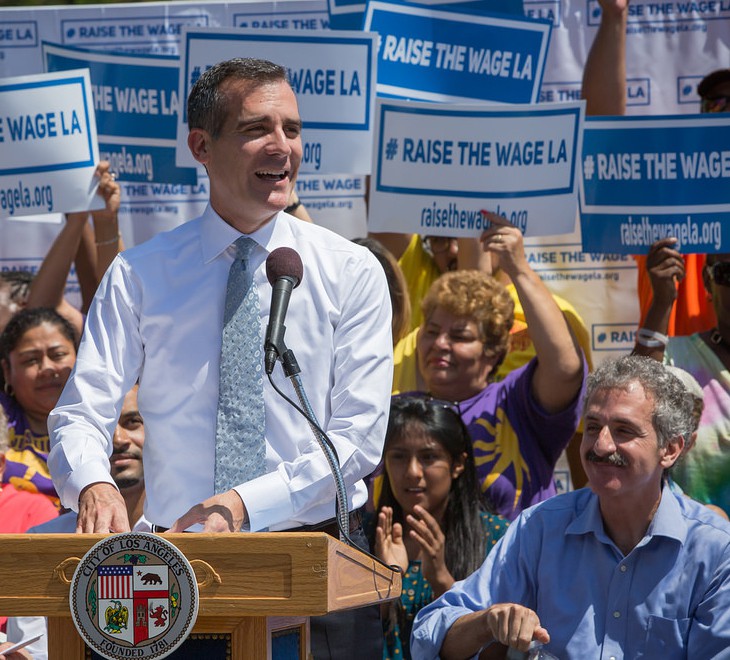FOR IMMEDIATE RELEASE: Tuesday, February 27, 2018
CONTACT: Aonya McCruiston, aonya.mccruiston@berlinrosen.com, 310-905-3191
Denise Luu, denise.luu@berlinrosen.com, 310.905.3193
“I lived in my car for three and a half months:” New Report Details Homelessness, Food Insecurity, Low Wages for Disneyland Employees
Researchers at Occidental College, Economic Roundtable found that 74 percent of Disneyland workers run out of money by the end of the month, can’t make ends meet
LOS ANGELES – A report released by researchers at Occidental College and the Economic Roundtable Tuesday finds that Disneyland employees in Anaheim, Calif. are paid so little, one in ten employees has experienced homelessness recently and two-thirds of park workers don’t have enough food to eat three meals a day.
Most Disneyland employees struggle to make ends meet: 74 percent (and 80 percent of those with children) say they can’t afford basic expenses every month. Eighty-five percent are paid less than $15 an hour. Many employees report limiting themselves to just one meal each day.
“I love my job, and I take great pride in working at Disney. I’m a licensed professional whose position requires years of experience – yet my wages are so low I often have to choose between food and a roof over my head,” said hair and makeup artist Rebekah Pederson. “I recently lived in my car for three and a half months, and I’m currently homeless again. I’m also a Type 1 diabetic and they had been switching me between part-time and full-time to curtail my benefits, so my healthcare situation has been overwhelming.”
Pederson is part of growing number of homeless people in Orange County. The issue of homelessness among Disneyland employees comes as officials in Orange County and in the city of Anaheim are under fire for inhumane treatment of hundreds of people living in an encampment just miles from Disneyland.
The report, “Working for the Mouse: A Survey of Disneyland Employees,” summarizes the findings of a survey of 5,000 employees who work at the resort and theme park in Southern California. The report was written by Peter Dreier, a professor of policy at Occidental College, and Daniel Flaming, the president of the Economic Roundtable.
“As Disneyland profits and prices hit record highs, Disneyland employees are falling farther behind,” Dreier said. “Disneyland wages aren’t keeping up with rising rents in Southern California. Our survey found that homelessness and housing instability are so widespread that they have become a normal part of employees’ lives at the park. Similarly, we found it’s normal for Disneyland workers to skip meals in order to make ends meet.”
“The value of workers’ pay has dropped 15 percent since 2000. Raising the wage floor to $20 an hour will give workers $190 million more a year to buy basic necessities for their families and it will generate $210 million more in sales by businesses in Anaheim and other communities where workers live,” Flaming said.
“I’ve spent the last 29 years working to give people a magical experience at Disneyland, and yet every month, I face choices between rent, food or bills,” said Glynndana Shevlin, a food and beverage concierge at the Disney E-Ticket Club. “I have been evicted twice. I work all day serving delicious food to people, yet I’m often hungry because I’m skipping meals. At work, I’m a clean, happy person, but when I leave and get in my car, I become a sad, unhappy person who doesn’t always know where they’re going to sleep.”
The independent report was commissioned by a coalition of unions representing Disneyland workers, including hair stylists, costumers, food service workers, candy makers, security guards, custodians, hotel workers, retail workers, ticket takers, musicians, puppeteers, singers and dancers. Seventy-nine percent of Disneyland employees are 30 years or older, 91 percent of employees report that Disneyland is their primary source of income and 33 percent of Disneyland employees have children. The report authors are exclusively responsible for all analysis, findings, and conclusions. The survey was conducted in Oct. 2017.
While Disneyland and the Walt Disney Co. have seen increased profits, employees have not shared in Disney’s success. In the past ten years, the number of visitors to the Disneyland Resort and theme park has increased from 20.6 million in 2006 to 27.2 million in 2016. Park revenue also increased from $1.72 billion to $3.03 billion in the same period. Merchandise costs, park attendance, and Walt Disney Co. revenue have also increased significantly. Last week, Disney increased Disneyland tickets by 9 percent with peak-period one-day tickets costing $135.
Wages for more than half of the union workers at Disneyland have decreased when adjusted for inflation, even as rents in Anaheim and surrounding areas have reached record highs. Eleven percent of respondents reported living in their cars or on friends’ floors and couches at some point in the last two years. This year, average rent is expected to hit $1,416 a month in Los Angeles County and $1,736 a month in Orange County, according to the USC Casden Multifamily Forecast. More than half of Disneyland workers are paid less than $12 an hour. Even among full-time employees who have worked at Disneyland for more than 15 years, 54 percent are paid less than $15 an hour and 13 percent are paid less than $11 an hour.
Key findings from the report include:
● Homelessness:
○ 11% of Disneyland employees have been homeless in the last two years.
○ 56% of employees are worried about being evicted from their homes or apartments.
● Food Insecurity:
○ 68% of employees, and 76% of employees with children, lack access to sufficient, safe, and nutritious food necessary to lead a healthy life (compared to 11.8 percent of people statewide).
● Low wages:
○ 74% of workers say they do not earn enough money for basic expenses every month.
○ 85% of workers are paid less than $15 an hour.
● Healthcare:
○ 42% of full-time employees covered by the Disneyland Resort’s health insurance plan report that the monthly premiums are too expensive
○ 43% of employees report say they needed, but could not afford, dental care in the past year.
Disney recently acquired 21st Century Fox’s film and TV studios in a landmark deal worth over $52 billion. Bob Iger, the CEO of the Walt Disney Co. earned $36.3 million in 2017 along with a bonus of Disney stock valued at $27.5 million. According to Bloomberg, he could earn $162.5 million in stock and cash bonuses in 2018. The L.A. Times estimates that, over the last two decades, Disney secured subsidies, incentives, rebates and protections from future taxes in Anaheim that would be worth more than $1 billion altogether. Recently, Anaheim leaders like Mayor Tom Tait and Councilman Jose Moreno questioned whether the city has seen an equitable return on its investment in Disney.
The coalition of unions includes: American Federation of Musicians Local 7; American Guild of Variety Artists (AGVA); Bakery, Confectionery, Tobacco Workers & Grain Millers International Union Local 83; International Alliance of Theatrical Stage Employees (IATSE) Local 504; IATSE Local 923; IATSE Local 706; Independent Employee Service Association (IESA); Service Employees International Union/United Service Workers West; United Food and Commercial Workers Local 324; UNITE HERE Local 11; and Workers United Local 50.
About the authors:
Peter Dreier is E.P. Clapp Distinguished Professor of Politics and chair of the Urban & Environmental Policy Department at Occidental College. He earned his Ph.D. from the University of Chicago.
Daniel Flaming is president of the Los Angeles Economic Roundtable, a nonprofit research organization that analyzes economic, social, and environmental conditions. He earned his Ph.D. from the University of Southern California.
###













